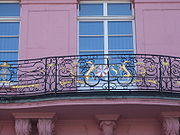
Bassenheimer Hof
Encyclopedia
The Bassenheimer Hof is an historic building in Mainz
, western Germany.
At present (2009) the large structure is the seat of the Ministry of the Interior and Sports of the federal state
of Rhineland-Palatinate
.
 The Bassenheimer Hof was erected in 1750 per the plans of the electoral master builder (Oberbaudirektor) Anselm Franz von Ritter zu Groenesteyn
The Bassenheimer Hof was erected in 1750 per the plans of the electoral master builder (Oberbaudirektor) Anselm Franz von Ritter zu Groenesteyn
(or Grünstein) on behalf of the prince-elector as a retirement home for his sister the widow, the countess of Bassenheim. It was built near the Osteiner Hof
.
The architect had been particularly impressed, during his studies in Paris, by the Place Vendôme
and Hôtel de Torcy (Hôtel de Beauharnais), with their formal statements and their elegant construction, reflecting the baroque French style.
In 1792 Mainz was invaded and occupied by Adam Philippe, Comte de Custine
, at which time the clergy and nobility portion of the town's populace fled for safety. By 1835 the Bassenheimer Hof had been sold to the military government, and was converted into a barracks
. It continued as a barracks until 1889. As a result of this and other conversions, the original interior layout, as well as that of the surrounding gardens, is no longer in evidence.
After 1889 the interior space of the building was utilized as a coffee shop, then for the manufacturing of embroidered flags. During World War II the building was burned to the ground (1942). The French military government ordered its reconstruction in 1947–1948.
The reconstructed building served as the temporary site of the minister president of the German federal state of Rhineland-Palatinate, before its present use by Rhineland-Palatinate (beginning in 1960).
Mainz
Mainz under the Holy Roman Empire, and previously was a Roman fort city which commanded the west bank of the Rhine and formed part of the northernmost frontier of the Roman Empire...
, western Germany.
At present (2009) the large structure is the seat of the Ministry of the Interior and Sports of the federal state
States of Germany
Germany is made up of sixteen which are partly sovereign constituent states of the Federal Republic of Germany. Land literally translates as "country", and constitutionally speaking, they are constituent countries...
of Rhineland-Palatinate
Rhineland-Palatinate
Rhineland-Palatinate is one of the 16 states of the Federal Republic of Germany. It has an area of and about four million inhabitants. The capital is Mainz. English speakers also commonly refer to the state by its German name, Rheinland-Pfalz ....
.
History

Anselm Franz von Ritter zu Groenesteyn
Anselm Franz Freiherr von Ritter zu Groenesteyn was a Chamberlain of Electoral Mainz, privy counsellor, Majordomo, temporarily Vitztum , High Director of Building and exceptionally gifted architect...
(or Grünstein) on behalf of the prince-elector as a retirement home for his sister the widow, the countess of Bassenheim. It was built near the Osteiner Hof
Osteiner Hof
The Osteiner Hof is one of several Baroque-era palatial mansions along Schillerplatz square in the German city of Mainz. The mansion, along the southern edge of the square, was built in 1747-1752 by architect-soldier Johann Valentin Thomann for Franz Wolfgang Damian von Ostein, brother of Johann...
.
The architect had been particularly impressed, during his studies in Paris, by the Place Vendôme
Place Vendôme
Place Vendôme is a square in the 1st arrondissement of Paris, France, located to the north of the Tuileries Gardens and east of the Église de la Madeleine. It is the starting point of the Rue de la Paix. Its regular architecture by Jules Hardouin-Mansart and pedimented screens canted across the...
and Hôtel de Torcy (Hôtel de Beauharnais), with their formal statements and their elegant construction, reflecting the baroque French style.
In 1792 Mainz was invaded and occupied by Adam Philippe, Comte de Custine
Adam Philippe, Comte de Custine
Adam Philippe, Comte de Custine was a French general. Born in Metz, he began his military career as a captain in the Seven Years' War, where he learned to admire the modern military organisation of Prussia....
, at which time the clergy and nobility portion of the town's populace fled for safety. By 1835 the Bassenheimer Hof had been sold to the military government, and was converted into a barracks
Barracks
Barracks are specialised buildings for permanent military accommodation; the word may apply to separate housing blocks or to complete complexes. Their main object is to separate soldiers from the civilian population and reinforce discipline, training and esprit de corps. They were sometimes called...
. It continued as a barracks until 1889. As a result of this and other conversions, the original interior layout, as well as that of the surrounding gardens, is no longer in evidence.
After 1889 the interior space of the building was utilized as a coffee shop, then for the manufacturing of embroidered flags. During World War II the building was burned to the ground (1942). The French military government ordered its reconstruction in 1947–1948.
The reconstructed building served as the temporary site of the minister president of the German federal state of Rhineland-Palatinate, before its present use by Rhineland-Palatinate (beginning in 1960).

